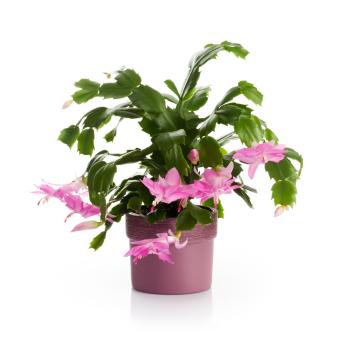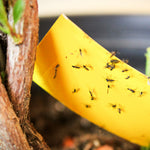A big topic of conversation recently (and always around this time of the year) is how to encourage "Christmas" cactus to bloom. These gorgeous houseplants are notorious for either taking breaks from blooming or blooming at seemingly random times of the year. So, let's have a look at what can be done.
The fundamentals
There are a few fundamentals to talk about before considering flowering specifically. Importantly, these plants are not at all like what we normally think of as cacti and, in fact, are tropical jungle plants. Holiday cacti are epiphytic in the wild, meaning they grow on trees and can also be found growing in the leaf debris on the forest floor. Two important growing tips come from this info: first, they thrive on bright diffuse light (not direct sun - red or orange leaves mean too much sun), and second, they prefer a humid environment. A third important lesson is that these epiphytes do not like to have wet feet, even if they do require more humidity up top than a typical cactus; so whatever growing medium and pots you are using, they need to be well draining. Generally speaking, holiday cacti do best when kept potbound but given enough room to develop into big plants, and allowed to drape. Last but not least, during the active growing season you'll want to provide monthly organic all-purpose fertilizer but stop feeding during the lead-up to flowering (they are not likely to bloom if not fertilized through the active growing season).
Even more confusing than these plants being called "cactus" is identifying what type of holiday cacti you might be growing, as there are at least three main categories and even then, the lines are not entirely clear.
The name we most often use is "Christmas" cactus, but in fact, there are also Thanksgiving and Easter cacti, plus hybrids that cross between the Christmas and Thanksgiving types (these two are both from the genus Schlumbergera while the Easter type is a closely related Rhipsadlidpsis). The association between the various species and these North American holidays is simply a function of when the various plants are likely to naturally bloom when grown in northern regions. And this largely explains why some "Christmas" cacti bloom out of season. All are short-day bloomers, but clearly, the Easter cactus has a different cycle compared to the others, responding to rising daylight hours versus the diminishing light cycle found in the lead-up to Thanksgiving and Christmas. One more interesting note: it is actually the amount of darkness, not light, that sets up flowering!
Aside from clues associated with the natural bloom time for each type of holiday cactus, there are other ways to tell them apart - important because they do not always behave (bloom) as expected. When you start to look closely, it becomes easy to see that each has a distinct leaf detail. Thanksgiving cacti are easiest to spot, as the leaves have pointed or hooked tufts on the leaf edges, while the Christmas type has softer but still distinct lobes and the Easter type has very subtle rounded lobes and overall larger, more rounded leaves.

Leaf details help identify what type of holiday cacti you are growing. From left: Christmas cactus, Thanksgiving cactus, and Easter cactus (at least likely... still waiting for this particular plant to bloom)
Flower colour is another physical feature that distinguishes them; Thanksgiving cacti have tubular blooms in a wide range of colours, Christmas cacti are also tubular and most often in shades of pink, and Easter cacti have larger and more vivid flowers that burst outwards in a star shape and may include unique colours such as orange. Finally, the growth habit of each holiday-themed cactus is unique, with Thanksgiving types standing more erect, Christmas types growing in an almost dangling habit and Easter cacti being smaller and generally upright.
Truth be told, most greenhouses selling "Christmas" cacti are actually selling the Thanksgiving type, as these hold up better in both shipping and retail displays. True Christmas cacti were once more popular, so when you hear about someone growing their great-grandmother's plant, these are usually the real deal! Easter cacti are harder to grow, as they are more sensitive to either over or under-watering which has made them less common at greenhouses. But they are out there and worth growing given they have some of the most spectacular flowers.
By the way, if you are noticing a similarity between the holiday cacti and what are usually called orchid cacti, you would be on to something as they are related epiphytic jungle cacti.
Getting holiday cactus to bloom

While all of the holiday cacti will bloom naturally, they can be unpredictable or underperform unless a few specific conditions are met. Essentially two things need to happen for the best results: 1) during the non-flowering season, be sure to water and feed the cacti regularly, providing ample diffuse light 2) create a contrasting dormant season with lower temperatures, reduced watering, and controlled darkness.
These plants prefer temperatures around 12C during the dormant season, and it is during this time that plants should be kept in 14 - 16 hours of complete darkness per day. By complete darkness, we are talking about absolutely no stray light (e.g. any light from under a closet door, nightlight, etc will interrupt the dark cycle). As soon as buds are visible, the plants need to be moved back to regular diffuse daylight and room temperature, avoiding locations with drafts. At this point, regular watering can resume. If cooler temperatures cannot be provided, adding up to two hours of darkness per day will help encourage bud formation. The pre-flowering treatment should last at least eight weeks, so plan this out if you want blooms for a particular date (all of the holiday cacti can bloom any time of the year if you can control conditions as described above).
Another strategy is to leave holiday cacti outdoors in late summer into early fall when temperatures can naturally cool enough to trigger bud formation. The tricky thing about this strategy for cold-climate gardeners is that we only have a short fall season before night temperatures get too cold, so being attentive and moving plants indoors once overnight temperatures regularly fall below 10C is critical. We might also not have a long enough window of ideal temperatures depending on the year. Many gardeners report success using this technique without any dark treatment, but greenhouse growers looking to get the best blooms would definitely combine the cooler temperatures with dark isolation every day (a modified version of this plan would be a short fall outdoors followed by a shorter dark treatment once plants are indoors). If you decide to move your holiday cacti outdoors at any time, they do require shelter from direct sun, even in the fall when the sun's intensity goes down.
When your holiday cacti have finished flowering, trim off the old flowers and one leaf tip per stem to encourage bushiness and even more flowers the blooming season.
In summary, these delightful plants can be a little complicated to convince to be on our schedules... so feel free to simply give them their fundamentals and enjoy the blooms when they come; they are no less spectacular even if they are not completely in synch with our holidays.







